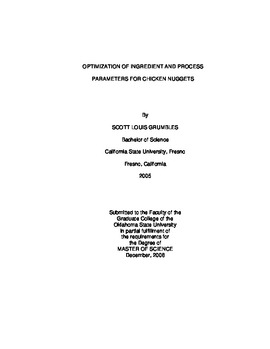| dc.description.abstract | The optimization of five different vegetable proteins (Arcon soy protein concentrate [ASP], Arcon Textured Vegetable Protein flour [ATVP], Supramax soy protein [SMXP], Solae Response soy protein [SRSP], and textured wheat protein, {Wheatex WP]) at three usage levels (10%, 20%, and 30%) were compared to a control industry standard chicken nugget. All nuggets were made uniform shape and size to evaluate weights throughout manufacturing: raw, battered and breaded, cooked (fried), frozen, and reheated. Control nuggets had the lowest (P < 0.05) raw, frozen and reheated weights among all treatments. Cooked weights were heaviest (P < 0.05) for WP 30%, among all treatments, excluding ASP 10%. Compositional properties, fat, moisture, protein, and pH were all taken in duplicate. There were no differences (P < 0.05) for compositional properties, fat, moisture, and protein among treatments. The pH of nuggets showed control to have the lowest (P < 0.05) pH of percentage treatment levels, except 10%. Sensory evaluations were performed using a consumer sensory panel. All nuggets scored in the acceptable category, regardless of percentage treatment level. Flavor profile was similar among all treatments. However, ATVP 30% and SRSP 30% scored lowest (P < 0.05) among all treatments and control. Wheat Protein 30% scored highest (P < 0.05) for juiciness and tenderness compared to all treatments and control, except WP 20%. Texture, overall likeability, and off-flavor showed no differences (P < 0.05) among all treatments and control. Texture profile was analyzed and showed ATVP to have the highest numerical value among all treatments and control. Vegetable proteins had the ability to be incorporated into chicken nuggets for the purpose of reducing production costs, by adding and retaining weight throughout manufacturing, when compared to a control nugget. Sensory attributes are not affected below the acceptable range across all treatments, yet some treatments where preferred in particular areas such as juiciness and tenderness. | |
